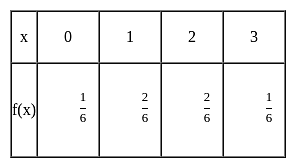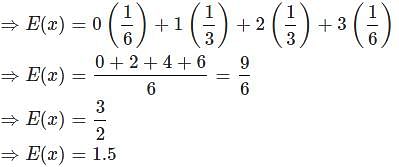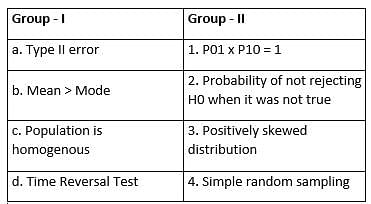UGC NET Paper 2 Economics Mock Test - 5 - UGC NET MCQ
30 Questions MCQ Test - UGC NET Paper 2 Economics Mock Test - 5
Consider the following statements and select the correct code:
1. ‘Confidence’, considered as one of the essential ingredients of economic prosperity is called ‘animal spirit’.
2. Animal spirit is a ‘naive optimism’.
1. ‘Confidence’, considered as one of the essential ingredients of economic prosperity is called ‘animal spirit’.
2. Animal spirit is a ‘naive optimism’.
If people expect that inflation is going to be 5% this year, they will try to get an increase in wages of 5% in anticipation of the higher prices. Seeking higher wages in fact will cause the inflation. This is the concept
that underlies
(A) Great expectations
(B) Adaptive expectations
(C) Mutual expectations
(D) Production expectations
(E) Rational expectations
that underlies
(A) Great expectations
(B) Adaptive expectations
(C) Mutual expectations
(D) Production expectations
(E) Rational expectations
| 1 Crore+ students have signed up on EduRev. Have you? Download the App |
Under which of the following approaches Phillips Curve Analysis holds good?
(a) Adaptive expectation
(b) Rational expectation
Choose the correct option:
‘Increasing incomes due to inflation pushes individuals into higher tax slabs and leaves them worse off’. This phenomenon is known as:
The principle of non-satiation, in utility theory suggests that:
(A) A consumer's utility decreases as they consume more of a good.
(B) A consumer gains no additional utility from consuming more of a good.
(C) Additional consumption does not affect a consumer's utility.
(D) A consumer's utility increases (or at least does not decrease) with additional consumption of a good.
(E) The more is better
Which of the following include problems in forecasting?
A. estimates becoming more reliable the further you forecast into the future
B. specification error
C. cyclical variation
D. stationarity in data series
E. consistency in data series
Choose the most appropriate answer from the options given below:
With reference to the Economic Survey 2022-23, consider the following statements regarding the Capex Multiplier:
1. Capex multiplier estimated for the country, the economic output of the country is set to increase by at least four times the amount of Capex
2. The multiplier effect is the proportional amount of increase or decrease in final income that results from an injection or withdrawal of spending respectively.
Which of the above statements is/are correct?
In a linear programming problem if the set of feasible solution is null set, then the problem has
Given below are two statements, one is labelled as Assertion (A) and the other as Reason (R).
Assertion (A): Urbanization and economic development are complementary to each other.
Reason (R): Cities have developed as a result of industrialization.
Select the correct answer using the code given below :
Match the items in Group - I with those of Group - II and select the correct answer from the code given below:
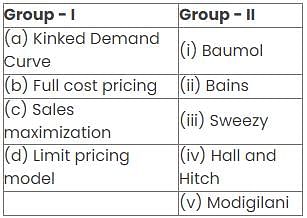
Consider the following statements regarding Real Effective Exchange Rate and select the correct answer from the codes.
(A) It refers to average of value country's currency in relation to an index of basket of values major countries currencies.
(B) It refers to nominal ratio of country's currency value to average value of a basket of currency.
The maximum value of Z = 3x + 4y subjected to the constraints 2x + y ≤ 4, x + 2y ≥ 12, x ≥ 0, y ≥ 0
With reference to the governance of public sector banking in India, consider the following statements:
1. Capital infusion into public sector banks by the Government of India has steadily increased in the last decade.
2. To put the public sector banks in order the merger of associate banks with the parent state Bank of India has been affected.
Which of the statements given above is/are correct?
According to the author of the passage, the demonetization move is only helpful when:
Which of the following is one of the main objectives of demonetization of Rs. 500 and Rs.1000 notes?
Consider the following statements.
a) The wealth tax was first levied in 1957.
b) Estate duty was first imposed in 1953 and abolished in 2016.
c) The gift tax was imposed in April 1958 as a complement to estate duty, wealth tax, and expenditure tax.
Which of the statement/s is /are incorrect?
Directions: Arrange the following in chronological order.
I. Indirect Tax Enquiry Committee (Jha Committee)
II. Tax Reforms Committee (Chelliah Committee)
III. Taxation Enquiry Commission (Mathur Commission)
IV. Direct Tax Enquiry Committee (Wanchoo Committee)
Which of the following are components of HDI?
I. Longetivity
II. Infant mortality
III. Educational attainment
IV. Decent standard of living
Find the expectation of a random variable x.
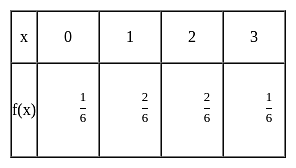
Consider the following statements:
1. Economic growth is measured through the human development index.
2. Economic development is measured through Gross Domestic Product.
3. Economic growth is a broader concept than economic development.
Which of the statements given above is/are correct?
Consider the following statements about India’s Industrial Policy 1991.
1. Liberalisation of Indian economy through reforms in Industrial licence.
2. De-reservation of many goods.
3. Financial Sector Reforms
4. Tax Reforms
Which of the statements given above is/are correct?



